MyBatis基础
MyBatis
官网:https://mybatis.org/mybatis-3/zh/index.html
1. 简介
1.1 什么是Mybatis
- MyBatis 是一款优秀的持久层框架
- 它支持自定义 SQL、存储过程以及高级映射。
- MyBatis 免除了几乎所有的 JDBC 代码以及设置参数和获取结果集的工作。
- MyBatis 可以通过简单的 XML 或注解来配置和映射原始类型、接口和 Java POJO(Plain Old Java Objects,普通老式 Java 对象)为数据库中的记录。
如何获得Mybatis
-
maven仓库
-
<!-- https://mvnrepository.com/artifact/org.mybatis/mybatis --> <dependency> <groupId>org.mybatis</groupId> <artifactId>mybatis</artifactId> <version>3.5.7</version> </dependency>
-
-
GitHub
- https://github.com/mybatis/mybatis-3/releases
1.2 持久层
数据持久化
- 持久化就是将程序得数据在持久状态和瞬时状转化得过程
- 内存:断电即失
- 数据库(jdbc),io文件持久化
1.3 持久层
- 完成持久化工作得代码块
- 层界限十分明显
1.4 为什么需要Mybatis
- 帮助程序员将数据库存入到数据库中
- 方便
- 简化,框架,自动化
- 优点:简单易学。灵活。sql和代码分离,提高可维护性。提高xml标签,支持动态编写sql
2. 第一个Mybatis程序
2.1 搭建环境
-
搭建数据库
-
新建项目
-
新建一个普通得maven项目
-
删除src文件
-
导入maven依赖
<!--导入依赖--> <!-- mybatis mysql驱动 junit--> <dependencies> <!-- mysql驱动 --> <dependency> <groupId>mysql</groupId> <artifactId>mysql-connector-java</artifactId> <version>8.0.23</version> </dependency> <!-- junit --> <dependency> <groupId>junit</groupId> <artifactId>junit</artifactId> <version>4.13.2</version> </dependency> <!-- mybatis --> <dependency> <groupId>org.mybatis</groupId> <artifactId>mybatis</artifactId> <version>3.5.7</version> </dependency> </dependencies>
-
2.2 创建一个模块
-
编写mybatis得核心配置文件、
mybatis-config.xml
<?xml version="1.0" encoding="UTF-8" ?> <!DOCTYPE configuration PUBLIC "-//mybatis.org//DTD Config 3.0//EN" "http://mybatis.org/dtd/mybatis-3-config.dtd"> <!-- configuration核心配置文件--> <configuration> <environments default="development"> <environment id="development"> <!-- JDBC配置--> <transactionManager type="JDBC"/> <dataSource type="POOLED"> <property name="driver" value="com.mysql.cj.jdbc.Driver"/> <property name="url" value="jdbc:mysql://localhost:3306/mybatis?useSSL=true&userUnicode=true&characterEncoding=UTF-8&serverTimezone=Aisa/Shanghai"/> <property name="username" value="root"/> <property name="password" value="123456"/> </dataSource> </environment> </environments> <mappers> <mapper resource="org/mybatis/example/BlogMapper.xml"/> </mappers> </configuration> -
编写mybatis得工具类

package com.mybatis.dao.utils; import org.apache.ibatis.io.Resources; import org.apache.ibatis.session.SqlSession; import org.apache.ibatis.session.SqlSessionFactory; import org.apache.ibatis.session.SqlSessionFactoryBuilder; import java.io.IOException; import java.io.InputStream; public class MybatisUtil { private static SqlSessionFactory sqlSessionFactory; static { try { // 填写配置文件的名称路径 String resource = "mybatis-config.xml"; // 读取xml文件 InputStream inputStream = Resources.getResourceAsStream(resource); // 通过工厂模式获得sqlSessionFactory对象 sqlSessionFactory = new SqlSessionFactoryBuilder().build(inputStream); } catch (IOException e) { e.printStackTrace(); } } // 既然有了 SqlSessionFactory,顾名思义,我们可以从中获得 SqlSession 的实例。 // SqlSession 提供了在数据库执行 SQL 命令所需的所有方法。 // 你可以通过 SqlSession 实例来直接执行已映射的 SQL 语句。 public static SqlSession getSqlSession() { return sqlSessionFactory.openSession(); } }
2.3 编写代码
-
实现类
package com.mybatis.dao.pojo; public class User { private Integer id; private String name; private String pwd; public User(Integer id, String name, String pwd) { this.id = id; this.name = name; this.pwd = pwd; } public User() { } public Integer getId() { return id; } public void setId(Integer id) { this.id = id; } public String getName() { return name; } public void setName(String name) { this.name = name; } public String getPwd() { return pwd; } public void setPwd(String pwd) { this.pwd = pwd; } } -
Dao接口类
package com.mybatis.dao; import com.mybatis.pojo.User; import java.util.List; public interface UserDao { List<User> getUserList(); } -
接口实现类 由 原来的接口实现类转化为现在的Mapper配置文件
<?xml version="1.0" encoding="UTF-8" ?> <!DOCTYPE mapper PUBLIC "-//mybatis.org//DTD Mapper 3.0//EN" "http://mybatis.org/dtd/mybatis-3-mapper.dtd"> <!-- namespace 绑定一个对应的Dao/Mappr接口--> <mapper namespace="com.mybatis.dao.UserDao"> <!-- 查询 id对应接口的方法名字 resultType返回类型--> <select id="getUserList" resultType="com.mybatis.pojo.User"> select * from mybatis.user </select> </mapper>
2.4 测试
- org.apache.ibatis.binding.BindingException: Type interface com.mybatis.dao.UserDao is not known to the MapperRegistry.
这个错误就是没有在核心配置文件里面注册
注意:每一个Mapper配置文件都需要在核心配置文件里面注册
<mappers>
<!-- Mappr文件路径-->
<mapper resource="com/mybatis/dao/UserMappr.xml"/>
</mappers>
- columnNumber: 19; 1 字节的 UTF-8 序列的字节 1 无效。
解决:1.还是建议XML不要有中文注释,2. 把核心配置文件里面的编码改为GBK(要和IDEA的编码一样),3. 把Maven的Pom.xml中的true改为false
- Caused by: java.io.IOException: Could not find resource com/mybatis/dao/UserMappr.xml
找不到xml文件,这是Maven资源过滤问题,需要在pom.xml里面手动配置资源过滤
解决:<!--在build中配置resources,来防止我们资源导出失败的问题--> <build> <resources> <resource> <directory>src/main/resources</directory> <includes> <include>**/*.properties</include> <include>**/*.xml</include> </includes> <filtering>true</filtering> </resource> <resource> <directory>src/main/java</directory> <includes> <include>**/*.properties</include> <include>**/*.xml</include> </includes> <filtering>true</filtering> </resource> </resources> </build>
-
junit测试
package com.mybatis.dao; import com.mybatis.pojo.User; import com.mybatis.utils.MybatisUtil; import org.apache.ibatis.session.SqlSession; import org.junit.Test; import java.util.List; public class UserDaoTest { @Test public void test() { // 获取sqlSession对象 SqlSession sqlSession = MybatisUtil.getSqlSession(); // 执行SQL 第一种方法: // 使用getMapper方法获取 实现接口 UserDao mapper = sqlSession.getMapper(UserDao.class); List<User> userList = mapper.getUserList(); for (User a : userList) { System.out.println(a); } // 关闭,释放资源 sqlSession.close(); } }// 了解即可,根据返回值来选择对应的方法 方式二: List<User> userList = sqlSession.selectList("com.mybatis.dao.UserDao.getUserList"); -
在test包里面进行
-
生命周期
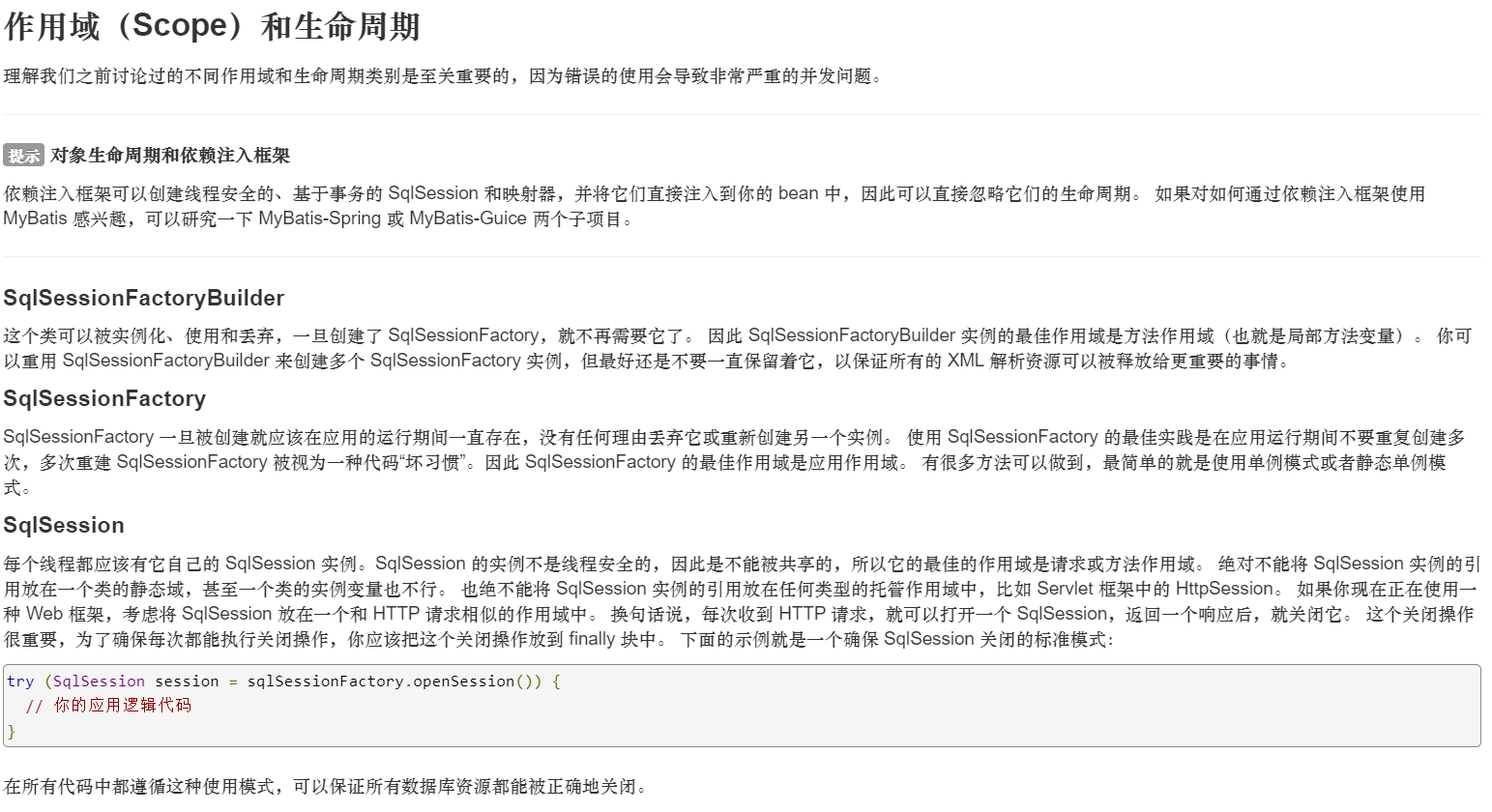
3. CRUD
记得提交事务,MyBatis需要手动提交
3.1 namespace
namespace 包名要和接口名称一致
3.2 CRUD-查Reader
-
id:就是对应的namespace中的方法名
-
resultType:SQL语句执行的返回值
-
parameterType:参数类型
<select id="getUserById" resultType="com.mybatis.pojo.User" parameterType="Integer"> # 接口传入地参数类型是什么,parameterType就写什么 # 接口传入的参数名称是什么,{}里面就写什么 select * from mybatis.user where id = #{id} </select>
3.3 CRUD-增:Create
- 增删改需要提交事务
@Test
public void setUserList() {
SqlSession sqlSession = MybatisUtil.getSqlSession();
UserMapper mapper = sqlSession.getMapper(UserMapper.class);
int userById = mapper.setUserByList(new User(5,"李氏","654"));
System.out.println(userById);
// 提交事务
sqlSession.commit();
sqlSession.close();
}
<!--对象里面的属性可以直接去出来用-->
<insert id="setUserByList" parameterType="com.mybatis.pojo.User">
insert into mybatis.user(id, name, pwd) VALUES (#{id},#{name},#{pwd})
</insert>
接口方法: int setUserByList(User user);
3.4 CRUD-改:Update
@Test
public void updateUserList() {
SqlSession sqlSession = MybatisUtil.getSqlSession();
UserMapper mapper = sqlSession.getMapper(UserMapper.class);
int userById = mapper.updateUserByList(new User(5,"函数","23315"));
System.out.println(userById);
// 提交事务
sqlSession.commit();
sqlSession.close();
}
// 修改
int updateUserByList(User user);
<update id="updateUserByList" parameterType="com.mybatis.pojo.User">
update mybatis.user
set name=#{name},
pwd=#{pwd}
where id = #{id};
</update>
3.5 CRUD-删:Delete
<delete id="deleteUserByList" parameterType="Integer">
delete
from mybatis.user
where id = #{id};
</delete>
// 删除
int deleteUserByList(Integer id);
@Test
public void deleteUserList() {
SqlSession sqlSession = MybatisUtil.getSqlSession();
UserMapper mapper = sqlSession.getMapper(UserMapper.class);
int userById = mapper.deleteUserByList(1);
System.out.println(userById);
// 提交事务
sqlSession.commit();
sqlSession.close();
}
4. 一些错误
- 看报错日志从后面开始看
5. Map和模糊查询
5.1 Map
如果数据库字段或参数过多,可以考虑
int set2UserByList(Map<String,Object> map);
<!-- 传递用map的KEY-->
<insert id="set2UserByList" parameterType="map">
insert into mybatis.user(id, name, pwd)
VALUES (#{a}, #{b}, #{c})
</insert>
@Test
public void set2UserList() {
SqlSession sqlSession = MybatisUtil.getSqlSession();
UserMapper mapper = sqlSession.getMapper(UserMapper.class);
HashMap<String,Object> map = new HashMap<>();
map.put("a", 1);
map.put("b", "sdasda");
map.put("c", "2112");
int userById = mapper.set2UserByList(map);
System.out.println(userById);
// 提交事务
sqlSession.commit();
sqlSession.close();
}
Map传递参数,直接在sql中取出key即可
对象传递参数,直接在sql中去对象的属性即可
多个参数用Map或注解
5.2 模糊查询
-
java代码传递的时候添加通配符 %%
List<User> get2UserList(String value);@Test public void test1() { SqlSession sqlSession = MybatisUtil.getSqlSession(); UserMapper mapper = sqlSession.getMapper(UserMapper.class); List<User> userList = mapper.get2UserList("%李%"); for (User a : userList) { System.out.println(a); } // 关闭,释放资源 sqlSession.close(); }<select id="get2UserList" resultType="com.mybatis.pojo.User"> select * from mybatis.user where name like #{value} </select> -
在sql语句中写通配符
<select id="get2UserList" resultType="com.mybatis.pojo.User"> select * from mybatis.user where name like "%"#{value}"%"; </select>
6 . 配置解析
6.1 核心配置文件
-
mybatis-config.xml
-
configuration(配置) properties(属性) settings(设置) typeAliases(类型别名) typeHandlers(类型处理器) objectFactory(对象工厂) plugins(插件) environments(环境配置) environment(环境变量) transactionManager(事务管理器) dataSource(数据源) databaseIdProvider(数据库厂商标识) mappers(映射器)
6.2 环境配置(environments)
MyBatis可以配置成适应多种环境
不过要记住:尽管可以配置多个环境,但每个 SqlSessionFactory 实例只能选择一种环境。
Mybatis默认的事务管理器是JDBC,连接池:POOLED
6.3 属性(properties)
这些属性可以在外部进行配置,并可以进行动态替换。
编写一个配置文件 db.properties
driver=com.mysql.cj.jdbc.Driver
url=jdbc:mysql://localhost:3306/mybatis?useSSL=true&userUnicode=true&characterEncoding=UTF-8
username=root
password=123456
在核心配置文件中引入
<properties resource="db.properties">
</properties>
使用
<!-- 引入外部配置-->
<properties resource="db.properties">
</properties>
<environments default="development">
<environment id="development">
<!-- JDBC配置 使用外部配置-->
<transactionManager type="JDBC"/>
<dataSource type="POOLED">
<property name="driver" value="${driver}"/>
<property name="url" value="${url}"/>
<property name="username" value="${username}"/>
<property name="password" value="${password}"/>
</dataSource>
</environment>
</environments>
- 可以直接使用外部文件
- 可以在引入时使用一些属性配置
- 如果什么两个同时存在,外部文件优先级高
这是核心配置文件写属性的顺序

6.4 类型别名(typeAliases)
- 类型别名可为 Java 类型设置一个缩写名字。 -
- 它仅用于 XML 配置,意在降低冗余的全限定类名书写。
- typeAlias:
<!-- 起别名-->
<typeAliases>
<typeAlias type="com.mybatis.pojo.User" alias="User"/>
</typeAliases>
- package:也可以指定一个包名,MyBatis 会在包名下面搜索需要的类,在没有注解的情况下,会使用 类名的首字母小写的非限定类名来作为它的别名。
<!-- 起别名-->
<typeAliases>
<package name="com.mybatis.pojo"/>
</typeAliases>
第一种可以自定义别名
第二种不能,但是可以通过注解来起别名@Alias("ni")
6.5 设置(settings)

[外链图片转存失败,源站可能有防盗链机制,建议将图片保存下来直接上传(img-D9k9t5Wn-1632751506113)(image-20210618201514692.png)]
6.6 其它
- typeHandlers(类型处理器)
- objectFactory(对象工厂)
- plugins(插件)
- mybatis-generator-core
- mybatis-plus
- 通用mapper
6.7 映射器(mappers)
注册绑定
方式一:
<mappers>
<!-- Mapper文件路径-->
<mapper resource="com/mybatis/Mapper/UserMapper.xml"/>
</mappers>
方式二:使用class文件绑定
<mappers>
<mapper class="com.mybatis.Mapper.UserMapper"/>
</mappers>
注意点:
- 接口和它的mapper配置文件必须同名
- 接口和它的mapper配置文件必须在同一个包下
方式三:使用扫描包
<mappers>
<package name="com.mybatis.Mapper"/>
</mappers>
注意点:
- 接口和它的mapper配置文件必须同名
- 接口和它的mapper配置文件必须在同一个包下
6.8 生命周期和作用域
生命周期和作用域是至关重要的,因为错误地使用会导致非常严重的并发问题
-
SqlSessionFactoryBuilder
- 一旦创建了 SqlSessionFactory,就不再需要它了
- 局部变量
-
SqlSessionFactory
- SqlSessionFactory 一旦被创建就应该在应用的运行期间一直存在,
没有任何理由丢弃它或重新创建另一个实例 - SqlSessionFactory 的最佳作用域是应用作用域,程序开始就开始,结束就结束
- 最简单的就是使用单例模式或者静态单例模式
- SqlSessionFactory 一旦被创建就应该在应用的运行期间一直存在,
-
SqlSession
- 连接到连接池的一个请求
- 关闭
- 它的最佳的作用域是请求或方法作用域
- 因为这个不是线程安全的,所有用完要马上关闭,否则会造成资源占用
7. ResultMap结果集映射
7.1 解决属性名和字段名不一致问题
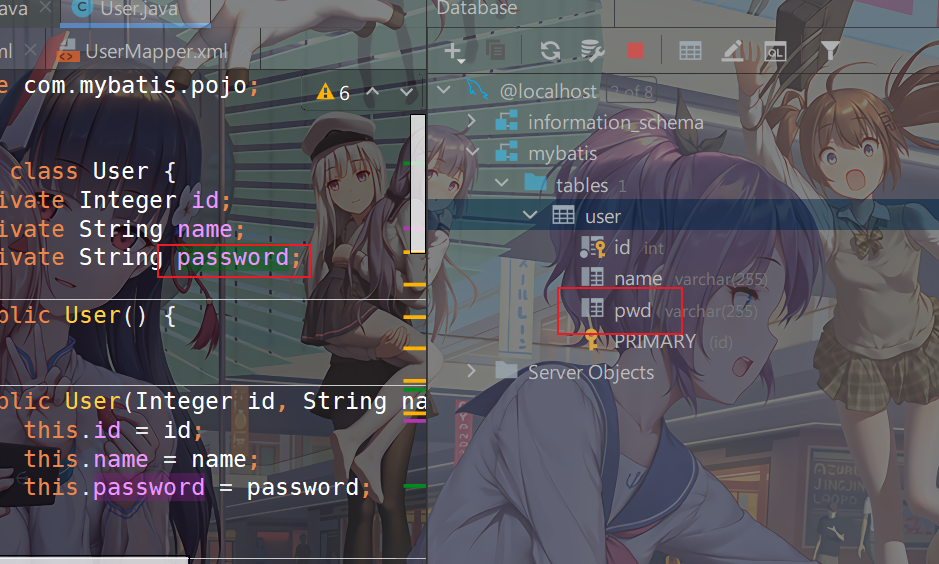
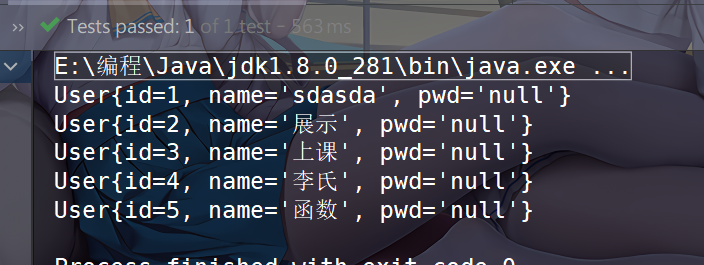
解决方法:
-
起别名
<select id="getUserList" resultType="com.mybatis.pojo.User"> select pwd as password,name,id from mybatis.user </select>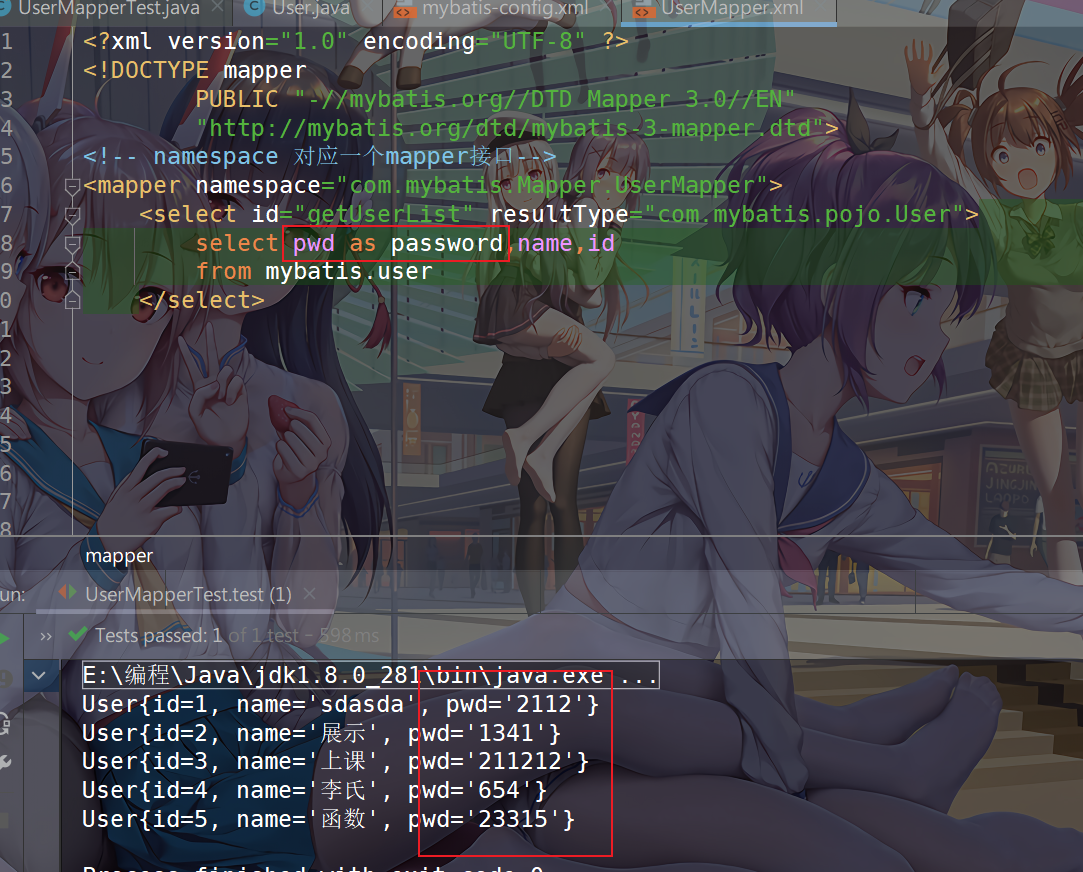
7.2 ResultMap

-
ResultMap 的设计思想是,对简单的语句做到零配置,对于复杂一点的语句,只需要描述语句之间的关系就行了。
-
ResultMap的优秀之处——你完全可以不用显式地配置它们高级结果映射看官方网站
8 日志
8.1 日志工厂
查看异常,排错,日志工厂是最好的助手
以前:sout,debug
现在:日志工厂

-
SLF4J
-
LOG4J【掌握】
-
LOG4J2
-
JDK_LOGGING
-
COMMONS_LOGGING
-
STDOUT_LOGGING【掌握】
-
NO_LOGGING
具体使用哪一个日志输出在设置中设定!
STDOUT_LOGGING标准日志输出
在核心配置文件里面配置
<settings>
<setting name="logImpl" value="STDOUT_LOGGING"/>
</settings>

8.2 Log4j
-
先导入log4j的包
<!-- https://mvnrepository.com/artifact/log4j/log4j --> <dependency> <groupId>log4j</groupId> <artifactId>log4j</artifactId> <version>1.2.17</version> </dependency> -
log4j配置文件log4j.properties
#将等级为DEBUG的日志信息输出到console和file这两个目的地,console和file的定义在下面的代码 log4j.rootLogger=DEBUG,console,file #控制台输出的相关设置 log4j.appender.console = org.apache.log4j.ConsoleAppender log4j.appender.console.Target = System.out log4j.appender.console.Threshold=DEBUG log4j.appender.console.layout = org.apache.log4j.PatternLayout log4j.appender.console.layout.ConversionPattern=[%c]-%m%n #文件输出的相关设置 log4j.appender.file = org.apache.log4j.RollingFileAppender log4j.appender.file.File=./log/wjj.log log4j.appender.file.MaxFileSize=10mb log4j.appender.file.Threshold=DEBUG log4j.appender.file.layout=org.apache.log4j.PatternLayout log4j.appender.file.layout.ConversionPattern=[%p][%d{yy-MM-dd}][%c]%m%n #日志输出级别 log4j.logger.org.mybatis=DEBUG log4j.logger.java.sql=DEBUG log4j.logger.java.sql.Statement=DEBUG log4j.logger.java.sql.ResultSet=DEBUG log4j.logger.java.sql.PreparedStatement=DEBUG -
配置log4j为日志的实现
<settings> <setting name="logImpl" value="LOG4J"/> </settings> -
log4j使用
直接测试运行代码
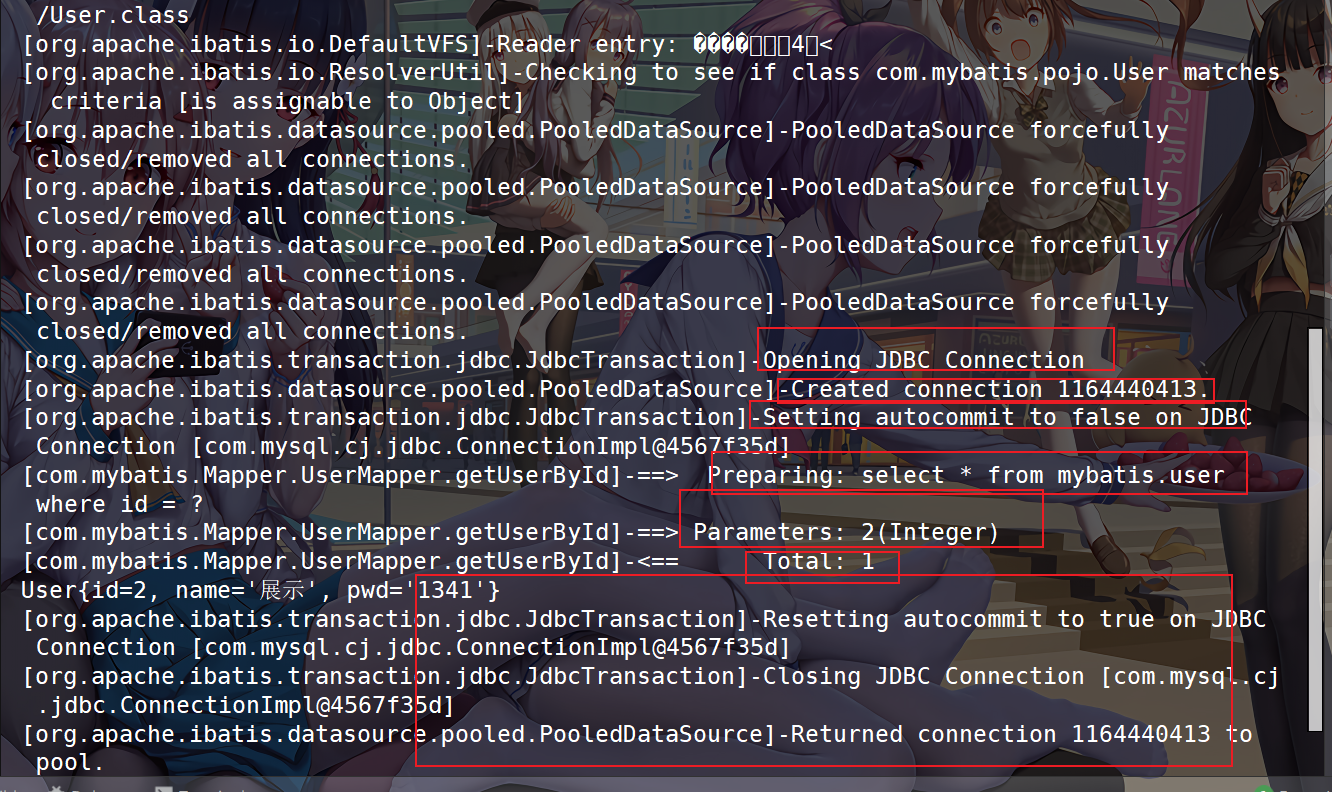
-
简单使用
-
在要使用日志的类类中导入包import org.apache.log4j.Logger;
-
日志对象,为当前类的class
static Logger logger = Logger.getLogger(UserMapperTest.class); -
日志级别
logger.info("info"); logger.debug("debug"); logger.error("error"); -
log文件
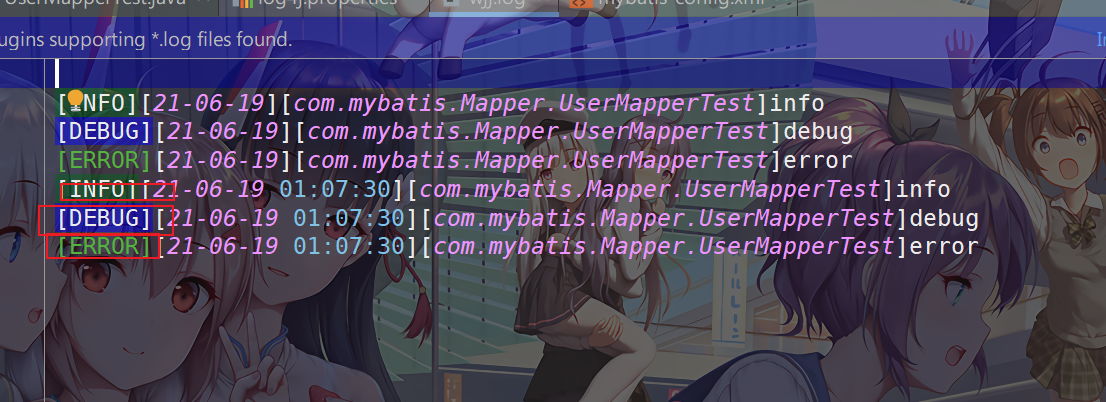
-
9. 分页
- 减少数据的处理量
9.1 使用Limlt分页
-
接口
// 分页 List<User> getUserByLimit(Map<String,Object> map); -
配置文件
<!-- 分页--> <select id="getUserByLimit" parameterType="map" resultType="User"> select * from mybatis.user limit #{startIndex},#{pageSize} </select> -
测试
@Test public void getUserByLimit() { SqlSession sqlSession = MybatisUtil.getSqlSession(); UserMapper mapper = sqlSession.getMapper(UserMapper.class); HashMap<String, Object> map = new HashMap<>(); map.put("startIndex", 2); map.put("pageSize", 2); List<User> userList = mapper.getUserByLimit(map); for (User user : userList) { System.out.println(user); } sqlSession.close(); }
9.2 RowBounds分页
不再使用SQL实现分页
-
接口
// rowBounds List<User> getUserByRowBounds(); -
配置文件
<!-- RowBounds分页--> <select id="getUserByRowBounds" resultMap="UserMap" resultType="User"> select * from mybatis.user </select> -
测试
@Test public void getUserByRowBounds(){ SqlSession sqlSession = MybatisUtil.getSqlSession(); RowBounds rowBounds = new RowBounds(1, 2); List<User> userList = sqlSession.selectList("com.mybatis.Mapper.UserMapper.getUserByRowBounds",null,rowBounds); for (User user : userList) { System.out.println(user); } sqlSession.close(); }
9.3 分页插件
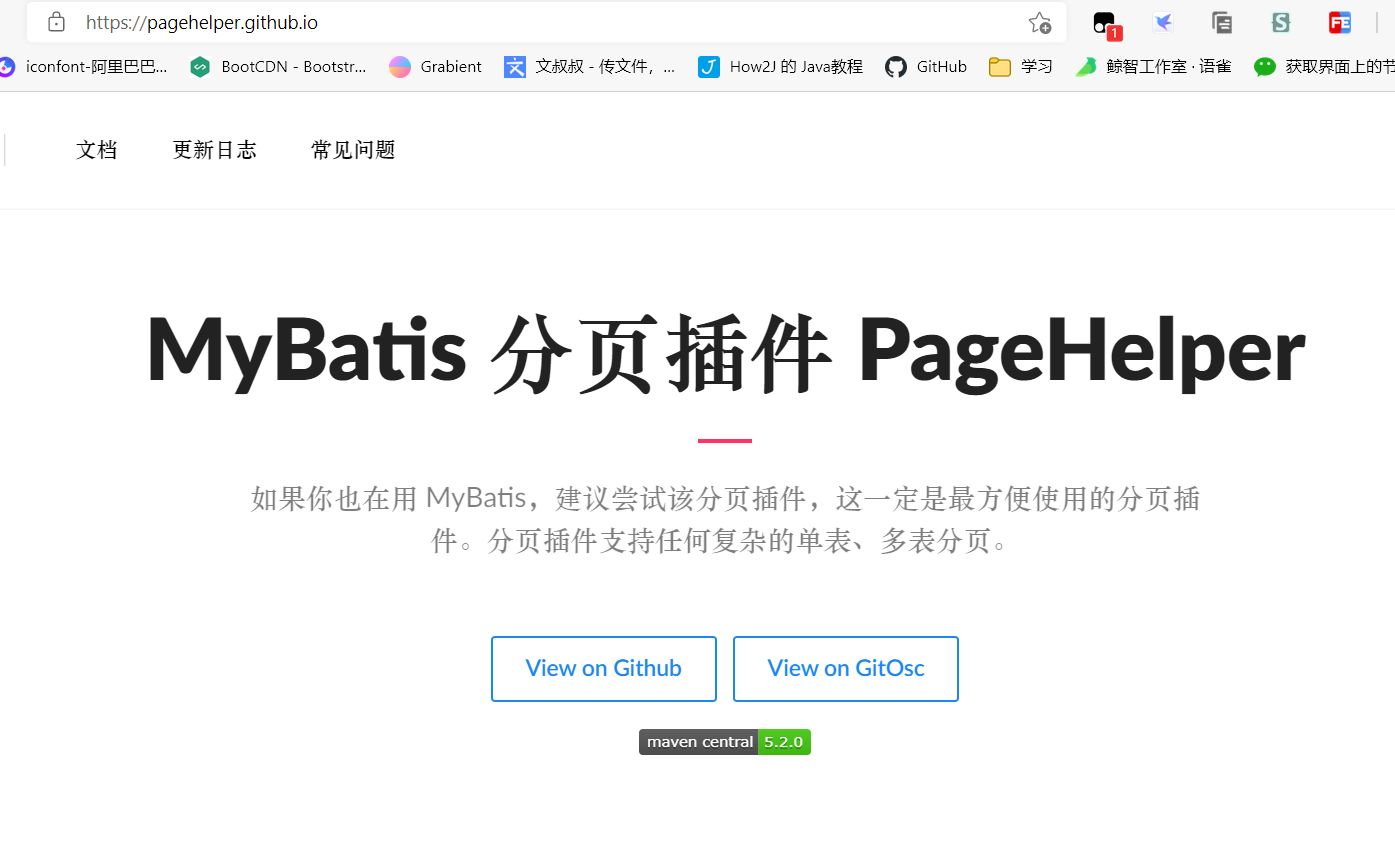
10. 使用注解开发
10.1 面向接口编程
大家之前都学过面向对象编程,也学习过接口,但在真正的开发中,很多时候我们会选择面向接口
编程
根本原因 : 解耦 , 可拓展 , 提高复用 , 分层开发中 , 上层不用管具体的实现 , 大家都遵守共同的标准
, 使得开发变得容易 , 规范性更好
在一个面向对象的系统中,系统的各种功能是由许许多多的不同对象协作完成的。在这种情况下,
各个对象内部是如何实现自己的,对系统设计人员来讲就不那么重要了;
而各个对象之间的协作关系则成为系统设计的关键。小到不同类之间的通信,大到各模块之间的交
互,在系统设计之初都是要着重考虑的,这也是系统设计的主要工作内容。面向接口编程就是指按
照这种思想来编程。
关于接口的理解
接口从更深层次的理解,应是定义(规范,约束)与实现(名实分离的原则)的分离。
接口的本身反映了系统设计人员对系统的抽象理解。
接口应有两类:
第一类是对一个个体的抽象,它可对应为一个抽象体(abstract class);
第二类是对一个个体某一方面的抽象,即形成一个抽象面(interface);
一个体有可能有多个抽象面。抽象体与抽象面是有区别的。
三个面向区别
- 面向对象是指,我们考虑问题时,以对象为单位,考虑它的属性及方法 .
- 面向过程是指,我们考虑问题时,以一个具体的流程(事务过程)为单位,考虑它的实现 .
- 接口设计与非接口设计是针对复用技术而言的,与面向对象(过程)不是一个问题.更多的体现就是对系统整体的结构
10.2 使用注解
-
注解再接口上实现
@Select("select * from user") List<User> getUserByList(); -
需要在核心配置文件中绑定接口!
<!-- 绑定接口--> <mappers> <mapper class="com.mybatis.Mapper.UserMapper"/> </mappers> -
测试,与其他无异
本质:反射机制实现
**底层:**动态代理!
mybatis执行流程!!!!
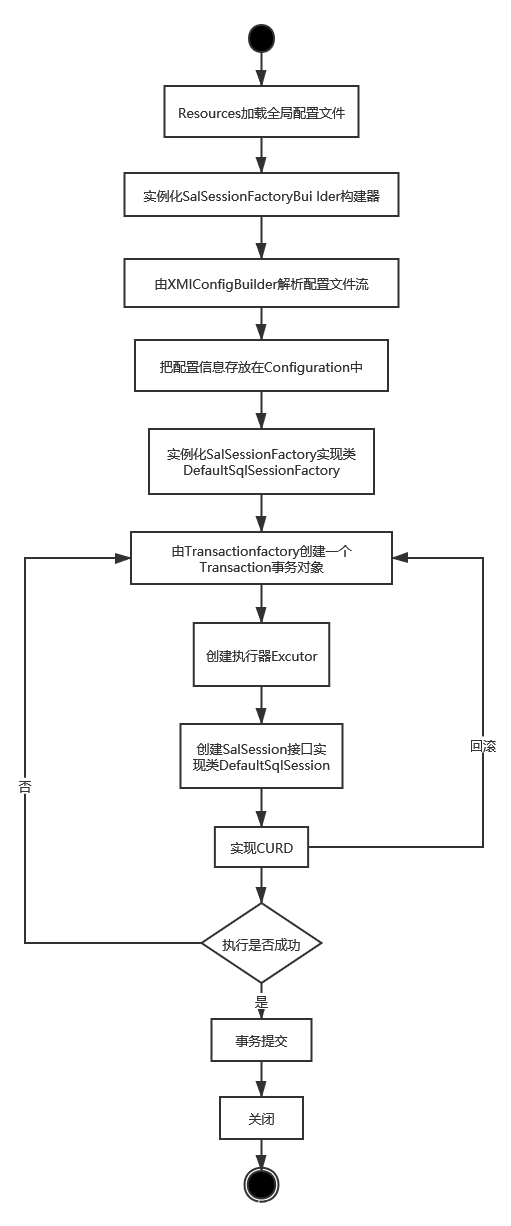
10.3 CRUD
可以在工具类创建的时候,实现事务自动提交
package com.mybatis.uitls;
import org.apache.ibatis.io.Resources;
import org.apache.ibatis.session.SqlSession;
import org.apache.ibatis.session.SqlSessionFactory;
import org.apache.ibatis.session.SqlSessionFactoryBuilder;
import java.io.IOException;
import java.io.InputStream;
public class MybatisUtil {
private static SqlSessionFactory sqlSessionFactory;
static {
try {
String resource = "mybatis-config.xml";
InputStream inputStream = Resources.getResourceAsStream(resource);
sqlSessionFactory = new SqlSessionFactoryBuilder().build(inputStream);
} catch (IOException e) {
e.printStackTrace();
}
}
//设置为true,实现事务自动提交
public static SqlSession getSqlSession() {
return sqlSessionFactory.openSession(true);
}
}
查: 注解Param的id对应 #里面的id
//方法如果存在多个参数,所有参数前面必须加上Param()注解 基本类型才需要加
@Select("select * from user where id = #{id}")
User getUserById(@Param("id") int id);
增:
@Insert("insert into user(id,name,pwd) values (#{id},#{name},#{password})")
int addUser(User user);
改:
@Update("update user set name = #{name},pwd = #{password} where id = #{id} ")
int updateUser(User user);
删:
@Delete("delete from user where id = #{uid}")
int deleteUser(@Param("uid") int id);
**注意:**关于@param()注解
- 基本类型和String类型。需要加上
- 引用类型不用
- 如果只由应该基本类型,可以忽略,但是建议加上
- 如果使用了这个,那么在SQL语句用的就是@param中设定的属性名
#{} 和 ${} 区别就是 一个是直接使用,一个预编译,$不安全
11. Lombok(尽量别用)
-
卸载lombok插件
-
导入依赖
<!-- https://mvnrepository.com/artifact/org.projectlombok/lombok --> <dependency> <groupId>org.projectlombok</groupId> <artifactId>lombok</artifactId> <version>1.18.20</version> <scope>provided</scope> </dependency> -
在实体类上加注解
- 类上加是作用全部参数
- 参数上加是作用当前参数
@Data:无参构造,get.set,hashCode,toString,equals…
@AllArgsConstructor:有参构造
@NoArgsConstructor:无参构造
@Getter and @Setter
@ToString
@EqualsAndHashCode
12. 多对一的处理
对于多而言:关联【多对一】
对于一而言:集合 【一对多】
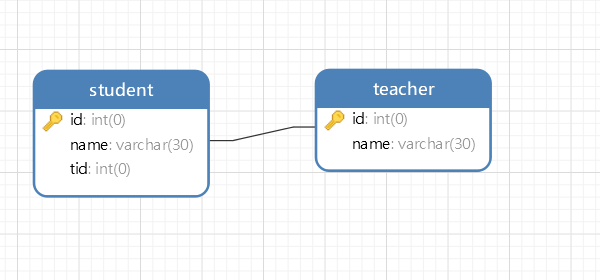
SQL:
CREATE TABLE `teacher` (
`id` INT(10) NOT NULL,
`name` VARCHAR(30) DEFAULT NULL,
PRIMARY KEY (`id`)
) ENGINE=INNODB DEFAULT CHARSET=utf8
INSERT INTO teacher(`id`, `name`) VALUES (1, 秦老师);
CREATE TABLE `student` (
`id` INT(10) NOT NULL,
`name` VARCHAR(30) DEFAULT NULL,
`tid` INT(10) DEFAULT NULL,
PRIMARY KEY (`id`),
KEY `fktid` (`tid`),
CONSTRAINT `fktid` FOREIGN KEY (`tid`) REFERENCES `teacher` (`id`)
) ENGINE=INNODB DEFAULT CHARSET=utf8INSERT INTO `student` (`id`, `name`, `tid`) VALUES (1, 小明, 1);
INSERT INTO `student` (`id`, `name`, `tid`) VALUES (2, 小红, 1);
INSERT INTO `student` (`id`, `name`, `tid`) VALUES (3, 小张, 1);
INSERT INTO `student` (`id`, `name`, `tid`) VALUES (4, 小李, 1);
INSERT INTO `student` (`id`, `name`, `tid`) VALUES (5, 小王, 1);
12.1 测试环境搭建
-
新建实体类Teacher Student
-
建立Mapper接口
-
建立Mapper.XML文件
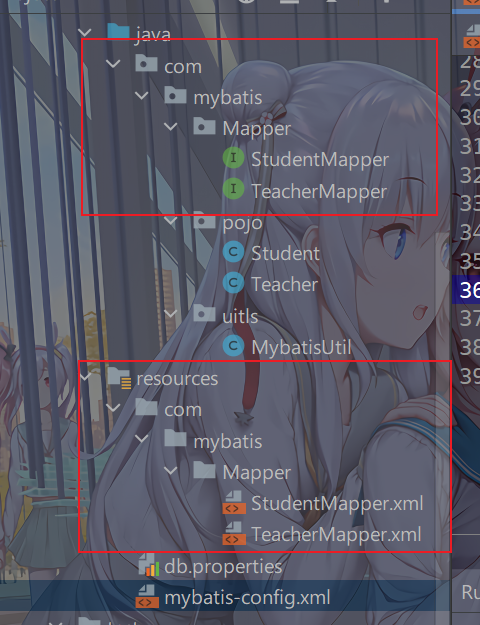
-
在核心配置文件中注册Mapper接口或XML文件
-
ce测试是否成功
12.2 多对一
- 按照查询嵌套处理
<mapper namespace="com.mybatis.Mapper.StudentMapper">
<select id="getStudent" resultMap="Student">
select *
from mybatis.student
</select>
<!-- 使用结果集映射 -->
<resultMap id="Student" type="Student">
<result property="id" column="id"/>
<result property="name" column="name"/>
<!-- 复杂的属性需要单独处理
association 对象使用
collection 集合使用
-->
<!-- javaType另外一个连接的实体类 select另外一个实体类的查询语句-->
<association property="teacher" column="tid" javaType="Teacher" select="getTeacher"/>
</resultMap>
<select id="getTeacher" resultType="Teacher">
select *
from mybatis.teacher
where id = #{id};
</select>
- 按照结构嵌套查询
<!--按照结果嵌套查询-->
<select id="getStudent2" resultMap="StudentTeacher">
select s.id sid, t.name tname, s.name sname
from mybatis.teacher t,
mybatis.student s
where t.id = s.tid
</select>
<!-- 取别名后,列对应的就是别名-->
<resultMap id="StudentTeacher" type="Student">
<result property="id" column="sid"/>
<result property="name" column="sname"/>
<association property="teacher" javaType="Teacher">
<result property="name" column="tname"/>
</association>
</resultMap>
多对一查询方式:
- 子查询
- 联表查询
13. 一对多
比如:一个老师对应多个学生
老师实体类:
package com.mybatis.pojo;
import java.util.List;
public class Teacher {
private Integer id;
private String name;
// 一个老师拥有多个学生
private List<Student> students;
}
学生实体类:
package com.mybatis.pojo;
public class Student {
private Integer id;
private String name;
private Integer id;
}
查询:
第一种:按结果查询
<select id="getTeacher" resultMap="Teacher">
select s.id sid, s.name sname, t.name tname, t.id tid
from mybatis.teacher t,
mybatis.student s
where s.tid = t.id
and t.id = #{id};
</select>
<resultMap id="Teacher" type="Teacher">
<result property="id" column="tid"/>
<result property="name" column="tname"/>
<!-- javaType="" 指定属性的类型
集合中的泛型使用ofType获取-->
<collection property="students" ofType="Student">
<result property="id" column="sid"/>
<result property="name" column="sname"/>
<result property="tid" column="tid"/>
</collection>
</resultMap>
第二种:按查询嵌套
<select id="getTeacher2" resultMap="Teacher1">
select *
from mybatis.teacher
where id = #{tid}
</select>
<resultMap id="Teacher1" type="Teacher">
<collection property="students" javaType="ArrayList" ofType="Student" select="getStudent" column="id"/>
</resultMap>
<select id="getStudent" resultType="Student">
select *
from mybatis.student
where tid = #{tid}
</select>
小结:
- 关联 — association【多对一】
- 集合 — collection 【一对多】
- javaType & ofType
- javaType 用来指定实体类中属性的类型
- ofType 用来指定泛型类型
注意点:
- 保证SQL可读性
- 注意一对多和多对一的属性字段问题
- 不好排查,可以使用日志
14. 动态SQL
**动态SQL:**就是根据不同的条件生成不同的SQL语句
如果你之前用过 JSTL 或任何基于类 XML 语言的文本处理器,你对动态 SQL 元素可能会感觉似曾相识。在 MyBatis 之前的版本中,需要花时间了解大量的元素。借助功能强大的基于 OGNL 的表达式,MyBatis 3 替换了之前的大部分元素,大大精简了元素种类,现在要学习的元素种类比原来的一半还要少。
- if
- choose (when, otherwise)
- trim (where, set)
- foreach
14.1 搭建环境
CREATE TABLE `blog`(
`id` VARCHAR(50) NOT NULL COMMENT '博客id',
`title` VARCHAR(100) NOT NULL COMMENT '博客标题',
`author` VARCHAR(30) NOT NULL COMMENT '博客作者',
`create_time` DATETIME NOT NULL COMMENT '创建时间',
`views` INT(30) NOT NULL COMMENT '浏览量'
)ENGINE=INNODB DEFAULT CHARSET=utf8
实体类:
import java.util.Date;
@Data
public class Blog {
private Integer id;
private String title;
private String author;
private Date create_time;
private Integer views;
}
随机ID工具类:
package com.mybatis.pojo;
import lombok.Data;
import java.util.Date;
@Data
public class Blog {
private String id;
private String title;
private String author;
private Date createTime;//属性名字和字段名字不一致
private Integer views;
}
IF:同java程序的判断无异
<select id="queryBlog" resultType="blog" parameterType="map">
select *
from mybatis.blog
where 1 = 1
# test 里面写表达式
<if test=" title != null ">
and title = #{title}
</if>
<if test=" author != null ">
and author = #{author}
</if>
</select>
choose、when、otherwise:同switch
<select id="queryBlogChoose" resultType="blog" parameterType="map">
select *
from mybatis.blog
<where>
<choose>
<when test="title != null">
title = #{title}
</when>
<when test="author != null">
and title = #{author}
</when>
<otherwise>
and views = #{views}
</otherwise>
</choose>
</where>
</select>
只要有一个成立就立即执行,其他就算处理也不要会执行
trim、where、set
where:尽量使用标签where
where 元素只会在子元素返回任何内容的情况下才插入 “WHERE” 子句。而且,若子句的开头为 “AND” 或 “OR”,where 元素也会将它们去除。
<select id="queryBlog" resultType="blog" parameterType="map">
select *
from mybatis.blog
<where>
<if test=" title != null ">
and title = #{title}
</if>
<if test=" author != null ">
and author = #{author}
</if>
</where>
</select>
set:写的时候记得加“,”
set 元素会动态地在行首插入 SET 关键字,并会删掉额外的逗号(这些逗号是在使用条件语句给列赋值时引入的)。
<update id="updateBlog" parameterType="map">
update mybatis.blog
<set>
<if test=" title != null">
title = #{title},
</if>
<if test=" author != null">
author = #{author}
</if>
</set>
where id = #{id}
</update>
trim:可以自定义的
动态SQL本质就是写逻辑语句
Foreach
@SuppressWarnings("all") //抑制警告
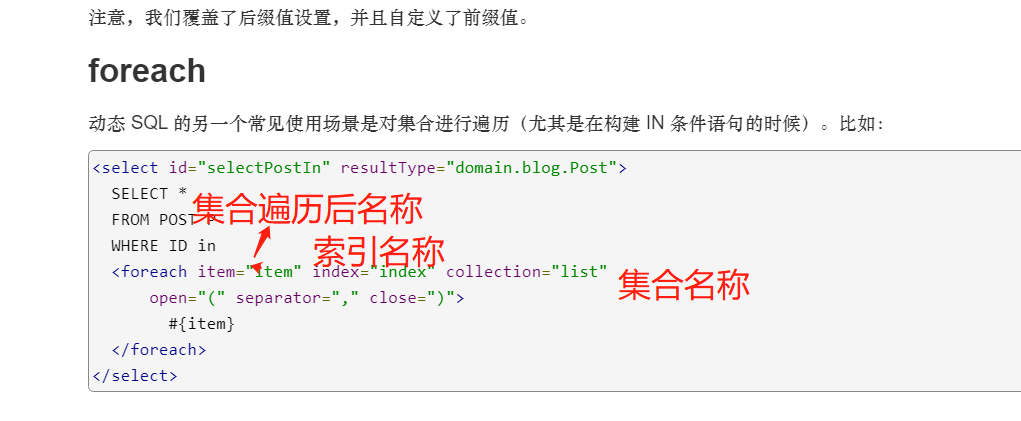
# 通过万能的map集合,把集合传过来 open开头 separator中间|分隔符 close结尾
#{id}为item的id
and后面记得空格
不用map也可以 ,直接传list
<select id="queryBlogForeach" parameterType="map" resultType="blog">
select * from mybatis.blog
<where>
<foreach collection="ids" item="id" index="index" open="and (" separator="or" close=")">
id = #{id}
</foreach>
</where>
</select>
</mapper>
@Test
public void test1(){
final SqlSession sqlSession = MybatisUtil.getSqlSession();
final BlogMapper mapper = sqlSession.getMapper(BlogMapper.class);
final HashMap map = new HashMap();
final ArrayList<Integer> ids = new ArrayList<>();
ids.add(1);
ids.add(2);
map.put("ids", ids);
final List<Blog> blogs = mapper.queryBlogForeach(map);
for (Blog blog : blogs) {
System.out.println(blog);
}
}
SQL片段
会将一些公共的抽取出来,实现代码的复用
sql标签抽取公共部分
<!--id随便取-->
<sql id="if">
<if test=" title != null">
title = #{title},
</if>
<if test=" author != null">
author = #{author}
</if>
</sql>
include在需要使用的地方进行引用
# 引用SQL片段
<include refid="if"></include>
注意:
- 尽量不要在多表查询的情况下使用
- 不要存在where标签
动态SQL就是在拼接SQL语句,我们要保证SQL语句正确,按照SQL的格式取排列就行了
建议:
- 先在mysql中写出完整语句,然后再慢慢拼接
15. 缓存
15.1 简介
注:Mybatis是半自动的持久化框架,灵活性更高
Hibernate是全自动的持久化框架
1.什么是缓存
- 存在内存中的临时数据
- 将用户经常查询的数据放在缓存(内存)中,用户去查询数据就不用从磁盘上(关系型数据库
数据文件)查询,从缓存中查询,从而提高查询效率,解决了高并发系统的性能问题。
2.为什么使用缓存
- 减少和数据库的交互次数,减少系统开销,提高系统效率。
3.什么样的数据能使用缓存?
- 经常查询并且不经常改变的数据。
15.2 Mybatis缓存
- MyBatis包含一个非常强大的查询缓存特性,它可以非常方便地定制和配置缓存。缓存可以极大的
提升查询效率。 - MyBatis系统中默认定义了两级缓存:一级缓存和二级缓存
- 默认情况下,只有一级缓存开启。(SqlSession级别的缓存,也称为本地缓存)
- 二级缓存需要手动开启和配置,他是基于namespace级别的缓存。
- 为了提高扩展性,MyBatis定义了缓存接口Cache。我们可以通过实现Cache接口来自定义二
级缓存
多个数据库保持一致性需要遵循主从复制和读写分离
15.3 一级缓存
- 一级缓存也叫本地缓存:SqlSession
- 与数据库同一次会话期间查询到的数据会放在本地缓存中。
- 以后如果需要获取相同的数据,直接从缓存中拿,没必须再去查询数据库;
测试步骤:
- 开启日志
- 在一个SqlSession中查询两次系统记录
- 查看日志输出
缓存失效的情况:
查询不同的东西
增删改操作,可能会改变依赖的数据,所以会刷新缓存
查询不同的mapper.xml
手动清理缓存
sqlSession.clearCache();
15.4 二级缓存
- 二级缓存也叫全局缓存,一级缓存的作用域太低了,所以诞生了二级缓存
- 基于namespace级别的缓存,一个名称空间,对应一个二级缓存
- 工作机制
- 一个会话查询一条数据,这个数据就会被放在当前会话的一级缓存中
- 如果当前会话关闭了,这个会话对应的一级缓存也就没了,但是我们想要的是,会话关闭了,一级缓存的数据被保存到二级缓存中
- 新的会话查询信息,就可以冲二级缓存中获取内容
- 不同的mapper查出的数据会自己放进对应的缓存(map)中
步骤:
-
开启全局缓存
<settings> <!-- 开启全局缓存--> <setting name="cacheEnabled" value="true"/> </settings> -
在mapper.xml文件里面使用
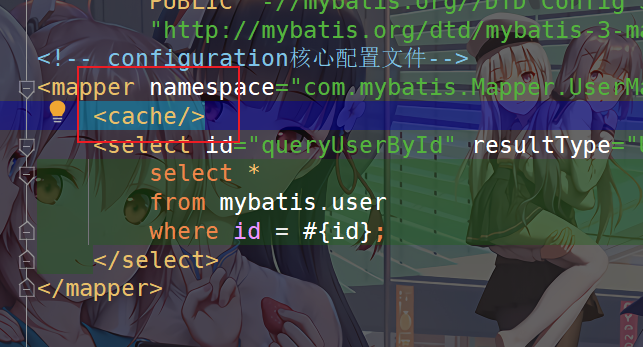
也可以自定义参数
<cache eviction="FIFO" flushInterval="60000" size="512" readOnly="true"/> -
测试
-
问题:我们需要将实体类序列化~否则就会报错
Error serializing object. Cause: java.io.NotSerializableException: com.mybatis.pojo.User
public class User implements Serializable {}
-
-
小结
- 只要开启了二级缓存,在同一个mapper有效
- 所有数据会先存在一级缓存中
- 只有会话提交或关闭时,才会提交到二级缓存
15.5 缓存原理
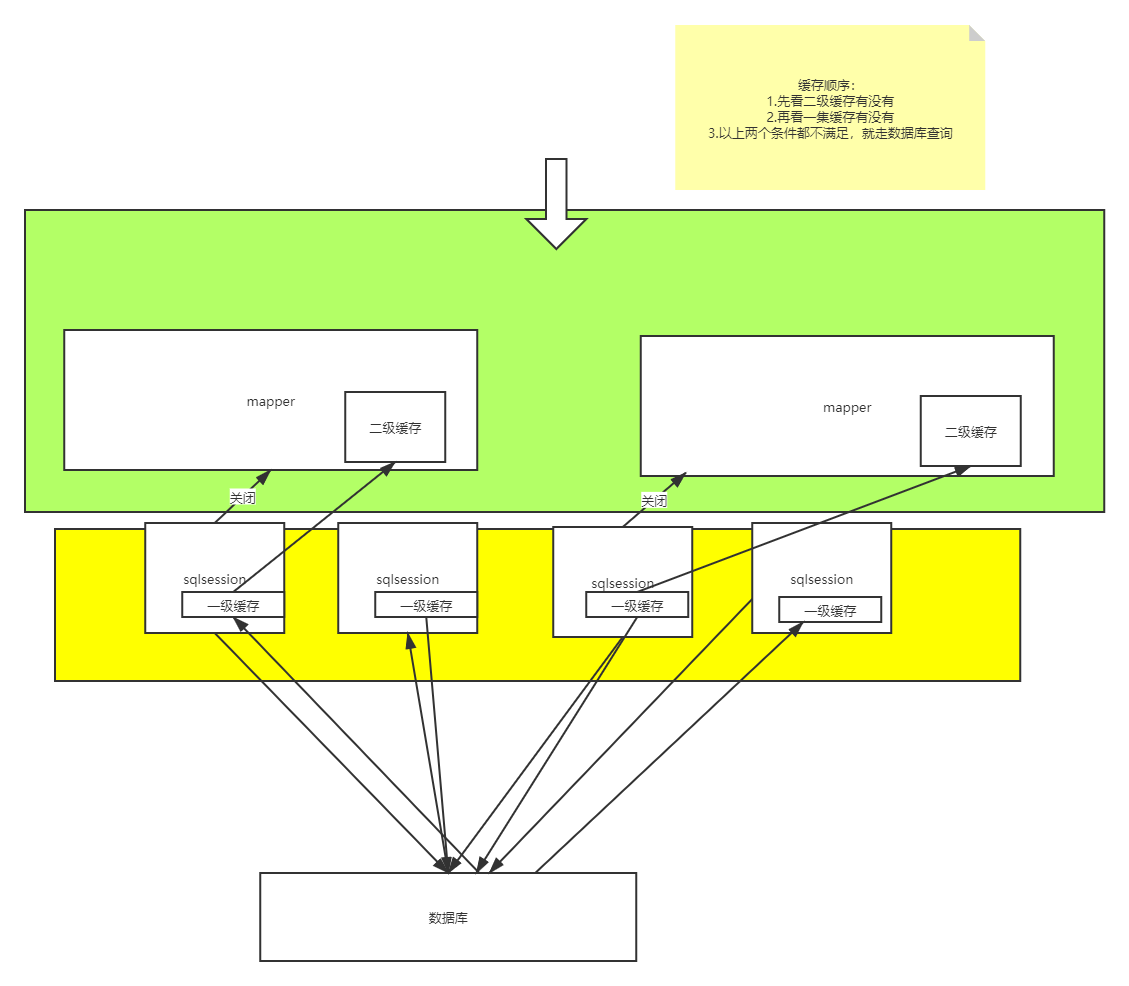
15.6 自定义缓存(ehcache)
-
导入依赖
<!--导入ehcache驱动--> <dependency> <groupId>org.mybatis.caches</groupId> <artifactId>mybatis-ehcache</artifactId> <version>1.1.0</version> </dependency> -
使用,在mapper.xml 里面
<cache type="org.mybatis.caches.ehcache.EhcacheCache"/> -
创建一个xml文件
<?xml version="1.0" encoding="UTF-8"?> <ehcache xmlns:xsi="http://www.w3.org/2001/XMLSchema-instance" xsi:noNamespaceSchemaLocation="http://ehcache.org/ehcache.xsd" updateCheck="false"> <!-- diskStore:为缓存路径,ehcache分为内存和磁盘两级,此属性定义磁盘的缓存位 置。参数解释如下: user.home – 用户主目录 user.dir – 用户当前工作目录 java.io.tmpdir – 默认临时文件路径 --> <diskStore path="./tmpdir/Tmp_EhCache"/> <defaultCache eternal="false" maxElementsInMemory="10000" overflowToDisk="false" diskPersistent="false" timeToIdleSeconds="1800" timeToLiveSeconds="259200" memoryStoreEvictionPolicy="LRU"/> <cache name="cloud_user" eternal="false" maxElementsInMemory="5000" overflowToDisk="false" diskPersistent="false" timeToIdleSeconds="1800" timeToLiveSeconds="1800" memoryStoreEvictionPolicy="LRU"/> <!-- defaultCache:默认缓存策略,当ehcache找不到定义的缓存时,则使用这个缓存策 略。只能定义一个。 --> <!-- name:缓存名称。 maxElementsInMemory:缓存最大数目 maxElementsOnDisk:硬盘最大缓存个数。 eternal:对象是否永久有效,一但设置了,timeout将不起作用。 overflowToDisk:是否保存到磁盘,当系统宕机时 timeToIdleSeconds:设置对象在失效前的允许闲置时间(单位:秒)。仅当 eternal=false对象不是永久有效时使用,可选属性,默认值是0,也就是可闲置时间无穷大。 timeToLiveSeconds:设置对象在失效前允许存活时间(单位:秒)。最大时间介于创建 时间和失效时间之间。仅当eternal=false对象不是永久有效时使用,默认是0.,也就是对象存 活时间无穷大。 diskPersistent:是否缓存虚拟机重启期数据 Whether the disk store persists between restarts of the Virtual Machine. The default value is false. diskSpoolBufferSizeMB:这个参数设置DiskStore(磁盘缓存)的缓存区大小。默 认是30MB。每个Cache都应该有自己的一个缓冲区。 diskExpiryThreadIntervalSeconds:磁盘失效线程运行时间间隔,默认是120秒。 memoryStoreEvictionPolicy:当达到maxElementsInMemory限制时,Ehcache将 会根据指定的策略去清理内存。默认策略是LRU(最近最少使用)。你可以设置为FIFO(先进先 出)或是LFU(较少使用)。 clearOnFlush:内存数量最大时是否清除。 memoryStoreEvictionPolicy:可选策略有:LRU(最近最少使用,默认策略)、 FIFO(先进先出)、LFU(最少访问次数)。 FIFO,first in first out,这个是大家最熟的,先进先出。 LFU, Less Frequently Used,就是上面例子中使用的策略,直白一点就是讲一直以 来最少被使用的。如上面所讲,缓存的元素有一个hit属性,hit值最小的将会被清出缓存。 LRU,Least Recently Used,最近最少使用的,缓存的元素有一个时间戳,当缓存容 量满了,而又需要腾出地方来缓存新的元素的时候,那么现有缓存元素中时间戳离当前时间最远的 元素将被清出缓存。 --> </ehcache> -
一般报错是测试类写错了,会话用到同一个



 浙公网安备 33010602011771号
浙公网安备 33010602011771号